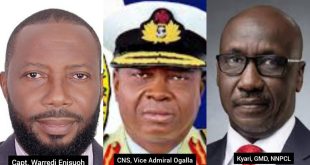 By Kenneth Jukpor
By Kenneth Jukpor
Over 1million twenty-foot equivalent units (TEU) containers and more than 10,000 trucks have been moved via barges in the last three years, since barging was introduced as a circumstantial development to dissipate the pangs of the impassable port access roads in 2018, nevertheless, the growing spate of accidents and colossal losses have become worrisome.
Although top companies in the Lagos port environs which require port services such as Danone Sugar, BUA, among others may have shutdown without the intervention of barging amid the chaotic port access roads, the accidents and incidents indicate a need for efficient regulation and adherence to Standards Operating Procedures (SOPs).
Given the barge disasters in the penultimate week; the former one by Mazamaza area which has been attributed to substandard jetty while the latter incident around Kirikiri was a loading issue and poor barge condition.
Each container is usually valued at about N10million and reports say that some of the affected containers were filled up with Plasma television sets and such containers should be valued at about N30million to N40million. Since an average barge carries 24 by 40ft containers. If one assumes that 48 containers were involved and multiply by N10million per container that gives N480million that has gone down the drain.

Speaking during a press briefing last week, the President of Barge Operators Association of Nigeria (BOAN) Mr. Kelikume Edeme noted that none of the barge accidents recorded involved a BOAN member, noting that several unlicensed operators are also carrying out barge operations.
Edeme assured users of barges that barges belonging to BOAN members are seaworthy, but couldn’t give such assurance for non-members in the practice.
According to him, BOAN has acquired a boat for inspection and partners the Nigerian Navy to have bi-monthly patrols to ensure that all barge operators are sticking to the standards, but had been shocked to find several unlicensed operators.
“We had situations from the last patrol we did, where we found a lot of people that were not licensed. People just bring their barges from Warri or other parts of the country like a bus or trailer, and they start operations in Lagos to make money. This practice is a recipe for disaster and it needs to be checked immediately and addressed,” he said.
The reasons for frequent barge accidents could be linked to several factors including rickety barges, bad jetties, insufficient regulation of the practice, lack of Standard Operating Procedures (SOPs), absence of call-up system for barges accessing seaports, improper loading, among others.
Licensing Regime
Barge operators are licensed by Nigerian Ports Authority (NPA) and there are numerous requirements including; N50million Bank Bond, Insurance, National Inland Waterways Authority (NIWA) certification for barges, having a standard jetty for your operations or a Memorandum of Understanding (MoU) with an established operational jetty, among others.
The problem is that several barge operators are going about their business without NPA license and no regulator has taken up the onus to fish out and clampdown on such operators.
Another challenge in the licensing regime is that NIWA and Lagos State Waterways Authority (LASWA) also issue licenses, leading to duplication of functions and flawed regulatory framework.
BOAN has been crying out over the influx of unlicensed and unregulated operators and this makes it difficult to manage the issues that lead to accidents.
Of all the barging accidents recorded in the last few years, none are members of BOAN. While this is commendable and may attract patronage for BOAN members, the absence of regulation and fiscal demands for licenses avail the unlicensed operators the opportunity to charge cheaper, thereby generating sufficient patronage to stay in the business.
Regulators and Overlapping Functions
Who is the principal body to license jetties in Nigeria today? The answer is up for a debate. There is no certainty to that. While NPA holds the domain for port related activities, NIWA claims responsibility for inland waterways, but no barge can get into the ports without going through the inland waterways. Most cargoes on the inland waterways are coming from the ports or heading to the ports. So, there is a dichotomy and overlap in functions. Does the sector need to create a separate body to handle these functions?
For port related activities, NPA should be able to license and regulate jetty operations. However, inland waterways activities for companies that have their factories at Agbara and move goods to Badagry, NIWA should be empowered to manage that activity which doesn’t require port operation.
Every barge being built in Nigeria would require a NIMASA sticker before it is commissioned. Therefore, NIMASA has to know the barges because they certify and class them. NIMASA should have details of every barge operating on Nigerian waterways on its database.
Nigerian Shippers’ Council (NSC) should wade into the cost of utilizing barges and collaborate with the operators to standardize the rates for various locations within the State. Operators should be encouraged to publish their tariffs to guide potential clients in choosing between barging and road haulage.
The Port Economic Regulator could also take up the onerous task to publish the set rules and SOPs with regards to picking and dropping cargoes via barges, liabilities on the part of parties involved, as such movement from one point to another is governed by contractual agreements.
“I am an advocate of opening up all strata of the maritime industry, including the barges operations. So, I totally agree that barge operations can thrive but on the basis of competition and not monopoly. There should be prompt regulation of the barge sector pursuance to the sustainability of its operations.”
“The biggest challenge in the industry is the absence of a professional pricing system at arriving of block charges for services rendered to the shipper. The economic regulator has a duty to evolve a pricing system detailing the service component of every charge meted to the shippers. Operators (service providers) hide under block charges for services; extort money for services not rendered or charges that have no cost functions, a former President of the National Association of Government Approved Freight Forwarders (NAGAFF), Chief Eugene Nweke said.
Fortunately, these agencies are under one Ministry, Transportation Ministry, and it is expected that they should easily coordinate their activities and collaborate with barge operators to enhance the practice in a safe and efficient manner.
Bad Jetties
Some barge jetties in Lagos have been labeled substandard by barge operators and industry experts, but the onus is on NIWA to address the menace.
Environmental Impact Assessment (EIA) is expected to be carried out before jetties are approved by NIWA for barge operations. Speaking with MMS Plus, a veteran maritime lawyer, Barr. Emmanuel Nwagbara noted that the minimum 250 meters distance between barge jetties has been flouted in the Kirikiri and Mazamaza environs where several jetties clog the area.
“The activities along the waterline from Kirikiri to Mile2, Ojo to Badagry, Ikorodu, Yaba and other areas are chaotic. The residents in those areas are in trouble because of unregulated barge operations. Barge operators use their trucks without regard to other road users and they don’t have sufficient parks for their customers and these areas have the roads perpetually blocked,” he said.
Beside the traffic gridlock and chaos in these affected areas, he equally lampooned the high rate of crime and violence as hoodlums thrive in such areas where alcoholic beverages and other illegal vices bloom.
“Barge jetties should be decent and coordinated like ferry terminals with restrooms, sufficient parking space and sales-points. Service users, especially truck drivers don’t have to abuse the environment by bathing on the roads, while people hawk alcoholic beverages and other items that leads to more violence in the area,” Nwagbara said.
The fact that most of these barge operators got NIWA license shows that there was no investigation as to the EIA of these facilities prior to the licensing. If NIWA knows that there are jetties for barge operations in these areas but they are illegal, what is the agency doing about it?
Barge jetties should also have sufficient tugboats and cranes to speedily respond to accidents and NPA should work in partnership with NIWA to certify the jetties that barge operators intend to utilize before granting licenses.
Efforts to extract comments from the General Manager, NIWA, Lagos Area Office, Mrs. Sarat Braimoh were futile until presstime, she couldn’t take or reply calls and text messages while our reporter waited endlessly in a bid to secure a meeting at her office, last week.
Lagos to Eastern Ports
Amid the numerous accidents involving barge operations in Lagos, the Managing Director of NIWA, Dr. George Moghalu, stated that NIWA is set to engage the services of Akewa Colmar Terminal Limited (ACTL) to move containers via barges from Lagos ports to Onitsha river port via Burutu port in Delta State.
Moghalu further disclosed that NIWA is targeting about 1,000 containers to be hauled per trip from Lagos Ports to Onitsha River Port within the maximum duration of 4 days.
While shipping experts argue that the challenges with barging in Lagos should inform a reconsideration of the Lagos to Onitsha decision, the NIWA boss argued that those who accuse NIWA of playing politics with the movement of containers from Lagos to Onitsha Port should ask Julius Berger, contractors of Third Niger Bridge where they have been taking delivery of the heavy equipment for the project.
Marine experts, however, posit that Julius Berger cargoes lie low in a barge while containers are stacked high and at the mercy of strong waves and rigors of non-dredged channels.
There are also concerns that the cost of barging from Lagos to Onitsha may far eclipse the road haulage fees as barging within Lagos already exceeds N500,000 per 40ft container.
Some questions boggle the minds of industry observers including; how many containers a barge needs to carry to break even? What is the maximum air draft required for height obstacles along the River Niger passage? Will the limitations in air draft bring the profit down to viable levels?
After watching the viral video of an overloaded barge going down in Lagos recently, has the investigation revealed the cause or the profit margin the operators were trying to hit before the accident?
NIWA should supply these answers to encourage barge operators to delve into the Lagos-Onitsha freight route. Providing this information and data will stimulate patronage by barge operators and shippers, not mere statements.
MMS Plus recalls the barge operation utilized to move 16 empty containers in one voyage from the Onitsha river port to Onne port and the barge operator who conveyed the containers, Mr. Kelikume Edeme lamented navigational troubles and security threats after the voyage.
A former Director, Shipping Development at Nigerian Maritime Administration and Safety Agency (NIMASA), Capt. Warredi Enisuoh also told our correspondent that the operation of the river port isn’t possible in its current state.
“In any business the first thing to consider is safety, but there is no safety of navigation to Onitsha river port. The channel to Onitsha is unmarked; hence, an insurance company would have to be stupid to insure such cargoes. What are the provisions for security? Would private security be hired to escort the ship or barge and is that arrangement constitutional? There is a restriction on night movement on the waterways which would affect such barge operations,” he queried.
Quick Wins
To address the lack of due process and SOPs for barge operations at the ports, the ports must work in sync with the stakeholders, port users and operators. The instances where barges have to queue up and block the channels either to load containers or unload should be eliminated. There should be waiting areas for barges and proper call-up systems to access the port terminals or berthing areas.
NIMASA and Nigerian Navy should develop strategies to stop operations of unlicensed barges, while NPA and NIWA synergize to get unlicensed barge jetties out of operations.
Tugboats should be attached to barges berthed in the port area to expedite response to salvage barges during accidents. Every barge should possess standard pumping machines which can be essential when barges start taking in water.
 MMS PLUS NG – Maritime, Aviation, Business, Oil and Gas News Online Newspaper with coverage in Maritime, Oil and Gas, Aviation, Power and Energy as well as Financial News
MMS PLUS NG – Maritime, Aviation, Business, Oil and Gas News Online Newspaper with coverage in Maritime, Oil and Gas, Aviation, Power and Energy as well as Financial News









